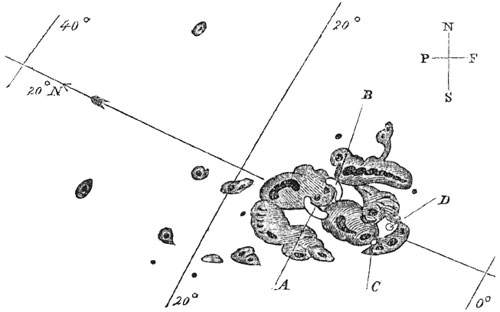Motivation
© Charles ChandlerOn 1859-09-01, at 11:18 GMT, an English astronomer named Richard Carrington made the first recorded observation of a solar flare.1 17 hours later, the largest geomagnetic storm in history occurred. Incredibly, the aurora was visible directly overhead as far south as the Caribbean.Figure 1. Carrington's drawing of the sunspots on 1859-09-01, with letters showing the locations of the flares.At the time, the event was little more than an idle curiosity. Consider the tone of following report from the Baltimore American and Commercial Advertiser.2Those who happened to be out late on Thursday [1859-09-01] night had an opportunity of witnessing another magnificent display of the auroral lights. The phenomenon was very similar to the display on Sunday [1859-08-28] night, though at times the light was, if possible, more brilliant, and the prismatic hues more varied and gorgeous. The light appeared to cover the whole firmament, apparently like a luminous cloud, through which the stars of the larger magnitude indistinctly shone. The light was greater than that of the moon at its full, but had an indescribable softness and delicacy that seemed to envelop everything upon which it rested. Between 12 and 1 o'clock, when the display was at its full brilliancy, the quiet streets of the city resting under this strange light, presented a beautiful as well as singular appearance.Aside from the pretty lights in the sky, there was one other effect: telegraph lines were overloaded with geomagnetically induced currents (GICs). Some of the lines burned out, while others continued to function, though the telegraph operators had to wait until the storm had passed, if they didn't want to get shocked while keying messages.The next time a storm like this hits us, it won't be just a curiosity. Rather, it will be a major catastrophe.3 Power lines will get knocked out, but not like in a normal power outage. We are all accustomed to going without electricity, sometimes for several days, usually because of extreme weather. The damage might be relatively local, or an entire region might be affected. Either way, repair crews from neighboring areas swarm in, and power is restored relatively quickly. But a geomagnetic storm isn't a regional event — it's global. What if power gets knocked out all over the world?The obvious problem is that there aren't enough repair crews to fix everything at once. The less obvious (but far more sobering) fact is that replacement parts will be in short supply, first because of the huge demand, and second because of the power outages at the manufacturing plants. So how do we replace blown-out line transformers, without the electricity necessary to manufacture new ones? In essence, our power grid has become like an organism. If one organ is injured, resources are diverted from other organs to repair the damage. But if too many organs are damaged, there aren't the resources to divert. This is when organs fail, increasing the hardship on the organism itself, possibly to the point of its demise. So too could our power grid die. And without electricity, we'll be in deep trouble. In 1859, people had no problem surviving without any new telegrams for a few days. But today, we will be hard-pressed to survive without electricity. If we all had fireplaces in our homes, we could all learn to chop wood to keep from freezing to death in the winter. But we have become so reliant on electricity that few people have fireplaces. Now what are we going to do?The good news is that a lot of the damage can be avoided if we shut down the power grid prior to the storm. The strength of a GIC is a function of the length of the wires. The grid in its entirety makes one huge antenna. But with all of the switches open, it's just a bunch of little antennas, and the currents won't be as strong.The bad news is that we don't know how to predict geomagnetic storms with sufficient confidence to order a global power-down, just in case it's another Carrington Event. Nor are we going to get that kind of capability with existing scientific strategies. The abstract and heuristic math that characterizes modern solar science is fine for after-the-fact rationalizations. But heuristics are bad at making accurate predictions, especially outside the range of what has already been recorded with modern instrumentation.To know a Carrington Event in near real time, with confidence, just on the basis of solar imagery, we need a mechanistic understanding of solar flares and CMEs, such that we can derive accurate predictions from the fundamental principles, instead of just quantifying past observations. And we need this as soon as possible — before the next event. Hence there is a great sense of urgency amongst astronomers to gain such a capability, since few things could be as devastating as a world-wide power outage.
References
1. Carrington, R. C. (1859): Description of a Singular Appearance seen in the Sun on September 1, 1859. Monthly Notices of the Royal Astronomical Society, 20: 13-15 ⇧
2. Dobbin, R. A.; Fulton, C. C. (1859): The Aurora Borealis. Baltimore American and Commercial Advertiser, 120 (19,654): pg. 2, col. 2 ⇧
3. Baker, D. N. et al. (2008): Severe Space Weather Events — Understanding Societal and Economic Impacts: A Workshop Report. National Academies Press ⇧











